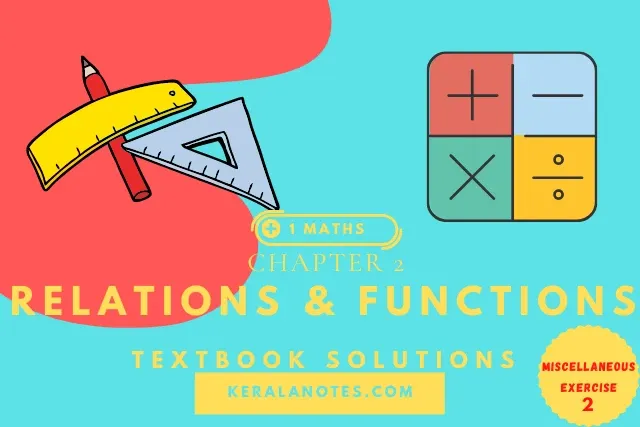In this chapter, you are provided with several diagrams and examples along with their solutions for a clear understanding of Relations and Functions. To know more about Class 11 Maths Chapter 2 Relations and Functions, you should explore the exercises below. You can also download the Sets Class 11 NCERT Solutions PDF
In this chapter, you’ll get a clear understanding of Relations and Functions. Both Relations and Functions have a different meaning in mathematics; however many get confused and use these words interchangeably. A ‘relation’ means a relationship between two elements of a set. It is a set of inputs and outputs, denoted as ordered pairs (input, output). We can also represent a relation as a mapping diagram or a graph. A relation can either be symbolised by Roster method or Set-builder method. On the other hand, a ‘function’ is a special type of relation, in which each input is related to a unique output. So, all functions are relations, but not all relations are functions.
| Board | SCERT, Kerala |
| Text Book | NCERT Based |
| Class | Plus One |
| Subject | Math's Textbook Solution |
| Chapter | Chapter 2 |
| Exercise | Miscellaneous Exercise |
| Chapter Name | Relations and Functions |
| Category | Plus One Kerala |
Kerala Syllabus Plus One Math's Textbook Solution Chapter 2 Relations and Functions Miscellaneous Exercise
Chapter 2 Relations and Functions Textbook Solution
Chapter 2 Relations and Functions Miscellaneous Exercise
If f(x) = x2, find![]() .
.

The relation f is defined by 
The relation g is defined by 
Show that f is a function and g is not a function.
The relation f is defined as
It is observed that for
0 ≤ x < 3, f(x) = x2
3 < x ≤ 10, f(x) = 3x
Also, at x = 3, f(x) = 32 = 9 or f(x) = 3 × 3 = 9
i.e., at x = 3, f(x) = 9
Therefore, for 0 ≤ x ≤ 10, the images of f(x) are unique.
Thus, the given relation is a function.
The relation g is defined as
It can be observed that for x = 2, g(x) = 22 = 4 and g(x) = 3 × 2 = 6
Hence, element 2 of the domain of the relation g corresponds to two different images i.e., 4 and 6. Hence, this relation is not a function.
Find the domain of the function ![]()
The given function is![]() .
.
![]()
It can be seen that function f is defined for all real numbers except at x = 6 and x = 2.
Hence, the domain of f is R – {2, 6}.
Find the domain and the range of the real function f defined by![]() .
.
The given real function is![]() .
.
It can be seen that![]() is defined for (x – 1) ≥ 0.
is defined for (x – 1) ≥ 0.
i.e., ![]() is defined for x ≥ 1.
is defined for x ≥ 1.
Therefore, the domain of f is the set of all real numbers greater than or equal to 1 i.e., the domain of f = [1,![]() ).
).
As x ≥ 1 ⇒ (x – 1) ≥ 0 ⇒ ![]()
Therefore, the range of f is the set of all real numbers greater than or equal to 0 i.e., the range of f = [0,![]() ).
).
Find the domain and the range of the real function f defined by f (x) = |x – 1|.
The given real function is f (x) = |x – 1|.
It is clear that |x – 1| is defined for all real numbers.
∴Domain of f = R
Also, for x ∈ R, |x – 1| assumes all real numbers.
Hence, the range of f is the set of all non-negative real numbers.
Let be a function from R into R. Determine the range of f.
be a function from R into R. Determine the range of f.

![]()
The range of f is the set of all second elements. It can be observed that all these elements are greater than or equal to 0 but less than 1.
[Denominator is greater numerator]
Thus, range of f = [0, 1)
Let f, g: R → R be defined, respectively by f(x) = x + 1, g(x) = 2x – 3. Find f + g, f – g and![]() .
.
f, g: R → R is defined as f(x) = x + 1, g(x) = 2x – 3
(f + g) (x) = f(x) + g(x) = (x + 1) + (2x – 3) = 3x – 2
∴(f + g) (x) = 3x – 2
(f – g) (x) = f(x) – g(x) = (x + 1) – (2x – 3) = x + 1 – 2x + 3 = – x + 4
∴ (f – g) (x) = –x + 4

Let f = {(1, 1), (2, 3), (0, –1), (–1, –3)} be a function from Z to Z defined by f(x) = ax + b, for some integers a, b. Determine a, b.
f = {(1, 1), (2, 3), (0, –1), (–1, –3)}
f(x) = ax + b
(1, 1) ∈ f
⇒ f(1) = 1
⇒ a × 1 + b = 1
⇒ a + b = 1
(0, –1) ∈ f
⇒ f(0) = –1
⇒ a × 0 + b = –1
⇒ b = –1
On substituting b = –1 in a + b = 1, we obtain a + (–1) = 1 ⇒ a = 1 + 1 = 2.
Thus, the respective values of a and b are 2 and –1.
Let R be a relation from N to N defined by R = {(a, b): a, b ∈ N and a = b2}. Are the following true?
(i) (a, a) ∈ R, for all a ∈ N
(ii) (a, b) ∈ R, implies (b, a) ∈ R
(iii) (a, b) ∈ R, (b, c) ∈ R implies (a, c) ∈ R.
Justify your answer in each case.
R = {(a, b): a, b ∈ N and a = b2}
(i) It can be seen that 2 ∈ N;however, 2 ≠ 22 = 4.
Therefore, the statement “(a, a) ∈ R, for all a ∈ N” is not true.
(ii) It can be seen that (9, 3) ∈ N because 9, 3 ∈ N and 9 = 32.
Now, 3 ≠ 92 = 81; therefore, (3, 9) ∉ N
Therefore, the statement “(a, b) ∈ R, implies (b, a) ∈ R” is not true.
(iii) It can be seen that (16, 4) ∈ R, (4, 2) ∈ R because 16, 4, 2 ∈ N and 16 = 42 and 4 = 22.
Now, 16 ≠ 22 = 4; therefore, (16, 2) ∉ N
Therefore, the statement “(a, b) ∈ R, (b, c) ∈ R implies (a, c) ∈ R” is not true.
Let A = {1, 2, 3, 4}, B = {1, 5, 9, 11, 15, 16} and f = {(1, 5), (2, 9), (3, 1), (4, 5), (2, 11)}. Are the following true?
(i) f is a relation from A to B (ii) f is a function from A to B.
Justify your answer in each case.
A = {1, 2, 3, 4} and B = {1, 5, 9, 11, 15, 16}
∴A × B = {(1, 1), (1, 5), (1, 9), (1, 11), (1, 15), (1, 16), (2, 1), (2, 5), (2, 9), (2, 11), (2, 15), (2, 16), (3, 1), (3, 5), (3, 9), (3, 11), (3, 15), (3, 16), (4, 1), (4, 5), (4, 9), (4, 11), (4, 15), (4, 16)}
It is given that f = {(1, 5), (2, 9), (3, 1), (4, 5), (2, 11)}
(i) A relation from a non-empty set A to a non-empty set B is a subset of the Cartesian product A × B.
It is observed that f is a subset of A × B.
Thus, f is a relation from A to B.
(ii) Since the same first element i.e., 2 corresponds to two different images i.e., 9 and 11, relation f is not a function.
Let f be the subset of Z × Z defined by f = {(ab, a + b): a, b ∈ Z}. Is f a function from Z to Z: justify your answer.
When 1 value of y gets mapped from 2 values of X makes f a non function
Let easy be the way when a+ b = 0 , a = -b
ab = - a×a which is multiple
E.g. - 4 = -2× 2 -2 + 2 = 0
-9 = -3×3 -3 + 3 = 0
Hence this is many to one which is not a function
Let A = {9, 10, 11, 12, 13} and let f: A → N be defined by f(n) = the highest prime factor of n. Find the range of f.
A = {9, 10, 11, 12, 13}
f: A → N is defined as
f(n) = The highest prime factor of n
Prime factor of 9 = 3
Prime factors of 10 = 2, 5
Prime factor of 11 = 11
Prime factors of 12 = 2, 3
Prime factor of 13 = 13
∴f(9) = The highest prime factor of 9 = 3
f(10) = The highest prime factor of 10 = 5
f(11) = The highest prime factor of 11 = 11
f(12) = The highest prime factor of 12 = 3
f(13) = The highest prime factor of 13 = 13
The range of f is the set of all f(n), where n ∈ A.
∴Range of f = {3, 5, 11, 13}
PDF Download
Chapter 2: Relations and Functions Miscellaneous Exercise Solution
Chapter 2: Relations and Functions Miscellaneous Exercise Solution- Preview
Plus One Math's Chapter Wise Textbook Solution PDF Download
- Chapter 1: Sets
- Chapter 2: Relations and Functions
- Chapter 3: Trigonometric Functions
- Chapter 4: Principle of Mathematical Induction
- Chapter 5: Complex Numbers and Quadratic Equations
- Chapter 6: Linear Inequalities
- Chapter 7: Permutation and Combinations
- Chapter 8: Binomial Theorem
- Chapter 9: Sequences and Series
- Chapter 10: Straight Lines
- Chapter 11: Conic Sections
- Chapter 12: Introduction to Three Dimensional Geometry
- Chapter 13: Limits and Derivatives
- Chapter 14: Mathematical Reasoning
- Chapter 15: Statistics
- Chapter 16: Probability
Plus One Math's Part I
Plus One Math's Part II
Plus One Maths Related Links
| Plus One Maths Notes | Click Here |
| Plus One Maths Textbook Solutions | Click Here |
| Plus One Focus Area | Click Here |
| Plus One Maths Previous Year Questions with Solution | Click Here |
| Plus One Latest Syllabus | Click Here |
Other Related Links
| Plus One Physics | Click Here |
| Plus One Chemistry | Click Here |
| Plus One Mathematics | Click Here |
| Plus One Botany | Click Here |
| Plus One Zoology | Click Here |
| Plus One Computer Science | Click Here |
| Plus One English | Click Here |






